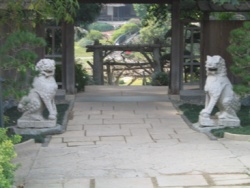Tea room lions and lion dogs of the huntington rose garden by Michelle Mackel
Tea room lions and lion dogs of the huntington rose garden
By Michelle Mackel
Among the many beautiful sculptures adorning the gardens of The Huntington, on the steps of the entrance to the Tea Room, adjacent to the Rose Garden, two identical marble lions stand guard. More charming than threatening, they hold ribbons in their mouths. Their seated pose makes them look relaxed, with their tails wrapped contentedly around their feet, yet they must be taken seriously as indicated by their massive, detailed paws and their slightly open mouths that partially reveal part of their fangs.
Arabella and Henry had some sort of private joke about these beribboned lions. They were originally from Arabella and Collis's country place, called The Homestead in Throggs Neck, New York (in the borough of The Bronx, New York City). Arabella and Henry spent considerable time there after their marriage until 1916. When the lions were first brought to San Marino, they were placed at the north entrance of the home (now The Huntington Art Gallery.)
Powerful and fearsome creatures, lions have been linked to humans in a magical way by most major civilizations. They are associated with the life-force of the sun (as opposed to darkness, representing the negation of life), secret wisdom, divine truth, royalty, or sometimes more specifically representing the fearlessness of one imbued with divine truth. Sculptures of lions provide a sense of majesty and awe and have been used as emblems of divine guardianship at gateways or doors to special places such as graves, spiritual places, hiding places of ancient wisdom, public buildings or in conjunction with statues of heroes. Lions as guardians are seen as far back as 3200 B.C. in Sumerian art.
The words, "King of the Beasts" dignifies the lion's power, however, it does not make any reference to the possible tyrannical associations of that phrase. We even use terms associated with lions to ennoble a person, such as "Richard, the Lion-Hearted" or a person's hair may be called "a noble mane".
Though undoubtedly lions were one of man's most threatening predators, the lion's destructive power is generally interpreted in a positive sense, a force vanquishing an enemy, for instance. It has been suggested that once man started hunting with weapons for food (and was not dependent on carrion), he needed courage and good hunting skills. To achieve these, rituals involving powerful animals like lions were performed in the hope of magically obtaining the hunting skills and courage observed in these large predators.
The lion was first introduced into China from India, with the introduction of Buddhism during the Han Dynasty. Lions figure in Buddhist mythology as guardians and mounts for certain important heavenly beings. When Buddhism moved from India into China, in the second century, these animals were transformed in shape and character. China had no lions originally, so the artists who sculpted the animals used their imaginations, and their familiarity with large dogs, to develop these symbols of the king of land animals. These half-dog and half-lion beasts, called "Foo" or "Fu" Dogs, became not just heavenly, but also earthly, guardians of good fortune. The word "Fo" means "Buddhism", "Fu" or "Foo" can mean happiness and this is probably where the name "Foo Dog" comes from, however there is a hypothesis that the name developed from the city of Foochow. Other names of these beasts are "Lion of Korea", "Celestial Dog" and "Dog of Happiness". As emblems of value and energy they are indispensable complements of wisdom. They are the companions of the Buddha.
Today Lion Dogs may be found protecting temples, tombs, business institutions, home entrances and government buildings from evil spirits. Though originally religious, their use became more secularized. They are also defenders of law. Their lion-like faces are often mischievous and almost devilish; their eyes are typically wide open with tiny dots in the middle. This gives them a threatening aspect to scare off any wrong-doers or evil demon spirits, thereby protecting the tranquility within the structure they guard.
The stone Lion Dogs at the west end of the Rose Garden sit across from each other, their heads turned to engage people coming down the central Rose Garden path on their way to the Japanese Garden. It is thought to be good luck to rub one's hand in the Lion Dogs’ mouths before entering the garden, which is why their tongues have been rubbed smooth.
The Lion Dog with a ball under his paw is the male. According to one explanation, the ball represents the globe, symbolizing the power under his paw. In Buddhism, the ball represents the pearl or jewel, symbol of Buddhist doctrine. The action of the lion playing ball, is also said to symbolize eternal happiness and prosperity. The male Lion Dog is the protector of the physical welfare of the family who owns the property.
The other Lion Dog is female and the little animal under her paw is the baby lion. Together they symbolize love and protection. She is the spiritual protector of the family. She guards the cub under her paw and feeds its spiritual goodness or knowledge from the "pearl of the spirit" on her chest. The pearl is the symbol for all that is holiest in the Buddhist religion.
The Lion Dogs' posture is more playful than that of the Tea Room Lions; their tails curl up behind them, ready for action. Their fur is more detailed as well. The curls of the manes, the backs of the legs and forelegs and around the tails add liveliness to the Lion Dogs as compared to the more smooth, calm marble dignity of the Tea Room Lions. Both pairs add delightfully to The Huntington experience.
Source
By Michelle Mackel, Rose Garden Docent and Co-Chair of Camellia Garden Docents
huntingtonbotanical.org
